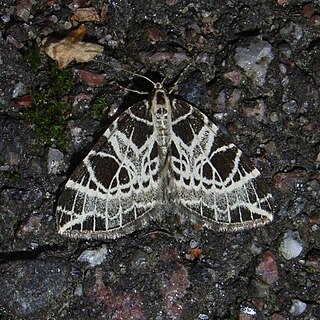
The geometer moths are moths belonging to the family Geometridae of the insect order Lepidoptera, the moths and butterflies. Their scientific name derives from the Ancient Greek geo γεω, and metron μέτρον "measure" in reference to the way their larvae, or "inchworms", appear to "measure the earth" as they move along in a looping fashion. A very large family, it has around 23,000 species of moths described, and over 1400 species from six subfamilies indigenous to North America alone. A well-known member is the peppered moth, Biston betularia, which has been subject of numerous studies in population genetics. Several other geometer moths are notorious pests.

Biston is a genus of large, long-winged moths belonging to the family Geometridae. It is most notable for containing the well-known peppered moth. The genus was first described by William Elford Leach in 1815.

The dotted border is a moth of the family Geometridae. The species was first described by Johan Christian Fabricius in 1776. It is found throughout Europe, except the far north, and the Near East.

Hedylidae, the "American moth-butterflies", is a family of insects in the order Lepidoptera, representing the superfamily Hedyloidea. They have traditionally been viewed as an extant sister group of the butterfly superfamily Papilionoidea. In 1986, Scoble combined all species into a single genus Macrosoma, comprising 35 currently recognized and entirely Neotropical species, as a novel concept of butterflies.

Lomographa bimaculata, the white-pinion spotted, is a species of geometer moth. It belongs to the large geometer moth subfamily Ennominae, and therein to the tribe Baptini. It is – under its junior synonym – the type species of its genus Lomographa. It is also the type species of Bapta, a junior objective synonym of Lomographa and the namesake of the Baptini. The species was first described by Johan Christian Fabricius ion 1775.
Cirrolygris is a monotypic moth genus in the family Geometridae first described by Warren in 1895. Its only species, Cirrolygris momaria, was first described by Snellen in 1874. It is found in Colombia.
Cophocerotis is a monotypic moth genus in the family Geometridae described by Warren in 1895. Its only species, Cophocerotis jaspeata, was first described by Paul Dognin in 1893. It is found in Ecuador.

Cosmorhoe is a monotypic moth genus in the family Geometridae erected by Jacob Hübner in 1825. Its only species, Cosmorhoe ocellata, the purple bar, was described by Carl Linnaeus in his 1758 10th edition of Systema Naturae.
Dystypoptila is a monotypic moth genus in the family Geometridae. Its only species, Dystypoptila triangularis, is found on the Indonesian island of Sumatra. Both the genus and species were first described by Warren in 1895.

Eustroma is a genus of moths in the family Geometridae erected by Jacob Hübner in 1825.
Hydatocapnia is a monotypic moth genus in the family Geometridae. Its only species, Hydatocapnia marginata, is found in the Naga Hills of India and Myanmar. Both the genus and species were first described by William Warren, the genus in 1895 and the species in 1893.

Pseudeuchlora is a monotypic moth genus in the family Geometridae erected by George Hampson in 1895. Its only species, Pseudeuchlora kafebera, was first described by Charles Swinhoe in 1894. It is found in Asia, including India.

Sterrhinae is a large subfamily of geometer moths with some 3,000 described species, with more than half belonging to the taxonomically difficult, very diverse genera, Idaea and Scopula. This subfamily was described by Edward Meyrick in 1892. They are the most diverse in the tropics with the number of species decreasing with increasing latitude and elevation.
Nelo is a genus of moths in the family Geometridae. Nelo discalis is the type species.

Eupitheciini is a tribe of geometer moths under subfamily Larentiinae, often referred to as pugs. The tribe was described by Tutt in 1896.
Louis Beethoven Prout (1864–1943) was an English entomologist and musicologist.

Scopula emutaria, the rosy wave, is a species of moth in the family Geometridae. It is found in western and south-western Europe and Romania. Also in North Africa.
William Warren was an English entomologist who specialised in Lepidoptera.
Rhodostrophiini is a tribe of the geometer moth family (Geometridae), with about 200 species in 17 genera and five genera tentatively associated with the tribe.
Caberini is a tribe of geometrid moths in the family Geometridae. There are at least 50 described species in Caberini.










